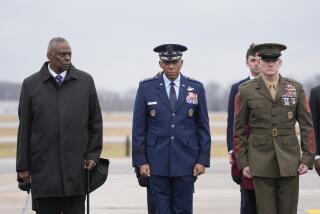Iraq Bombing’s Accuracy Below 50%, Official Says
- Share via
WASHINGTON — The U.S.-British bombing of Iraqi air defense sites last week damaged less than half the radars targeted, and the overall result was at best a modest success, a senior defense official said Wednesday.
The allies rate a B-minus or a C-plus as regards the bombing’s accuracy, the official said. He discussed the Pentagon’s preliminary damage assessment on condition of anonymity.
On Tuesday, Pentagon spokesman Rear Adm. Craig Quigley said that the airstrikes achieved their purpose of “disrupting and degrading” Iraq’s air defenses but that the military will not release a detailed public assessment of the attack’s effectiveness. To do so could help Iraq prepare for any future attacks, he said.
Quigley said the bombing by 24 American and British warplanes was a necessary response to indications that Iraq was integrating its air defenses in a way that would give Baghdad a better chance of shooting down allied planes. The bombs were aimed at radars and command-and-control “nodes” that link elements of the air defense network.
“We think we had an impact on that,” Quigley said. “Was it permanent? No.” Later, he said the Pentagon was pleased with the results, even if the bombs were not 100% effective. “It isn’t perfect,” Quigley said. “It never is.”
On Wednesday, officials confirmed a CBS News report that some of the bombs and missiles--known as precision-guided weapons because they are guided to their target by satellite links, infrared seekers or TV signals--were not as accurate as expected. CBS reported that eight of 20 targeted radars were hit. Some aspects of the guidance system apparently didn’t work properly.
The senior defense official said that he was not sure of the exact numbers but that the attackers hit less than 50% of the radars targeted. He said radars are difficult to hit because they do not have as much structural mass as a building or a bunker.
The official said the impact of more-successful strikes against facilities that command and control Iraq’s air defense system--including surface-to-air missile batteries--was likely to be more lasting than hitting radars, which can be repaired fairly quickly.
The Pentagon has refused to specify which weapons were used against Iraq, but they are likely to have included TV-guided AGM-130 missiles launched by Air Force F-15E strike aircraft and the AGM-154 joint standoff weapon, or JSOW, carried by Navy and Air Force jets. The guidance systems on these weapons allow a pilot to fire at a target from well beyond the range of hostile air defenses.
More to Read
Sign up for Essential California
The most important California stories and recommendations in your inbox every morning.
You may occasionally receive promotional content from the Los Angeles Times.













